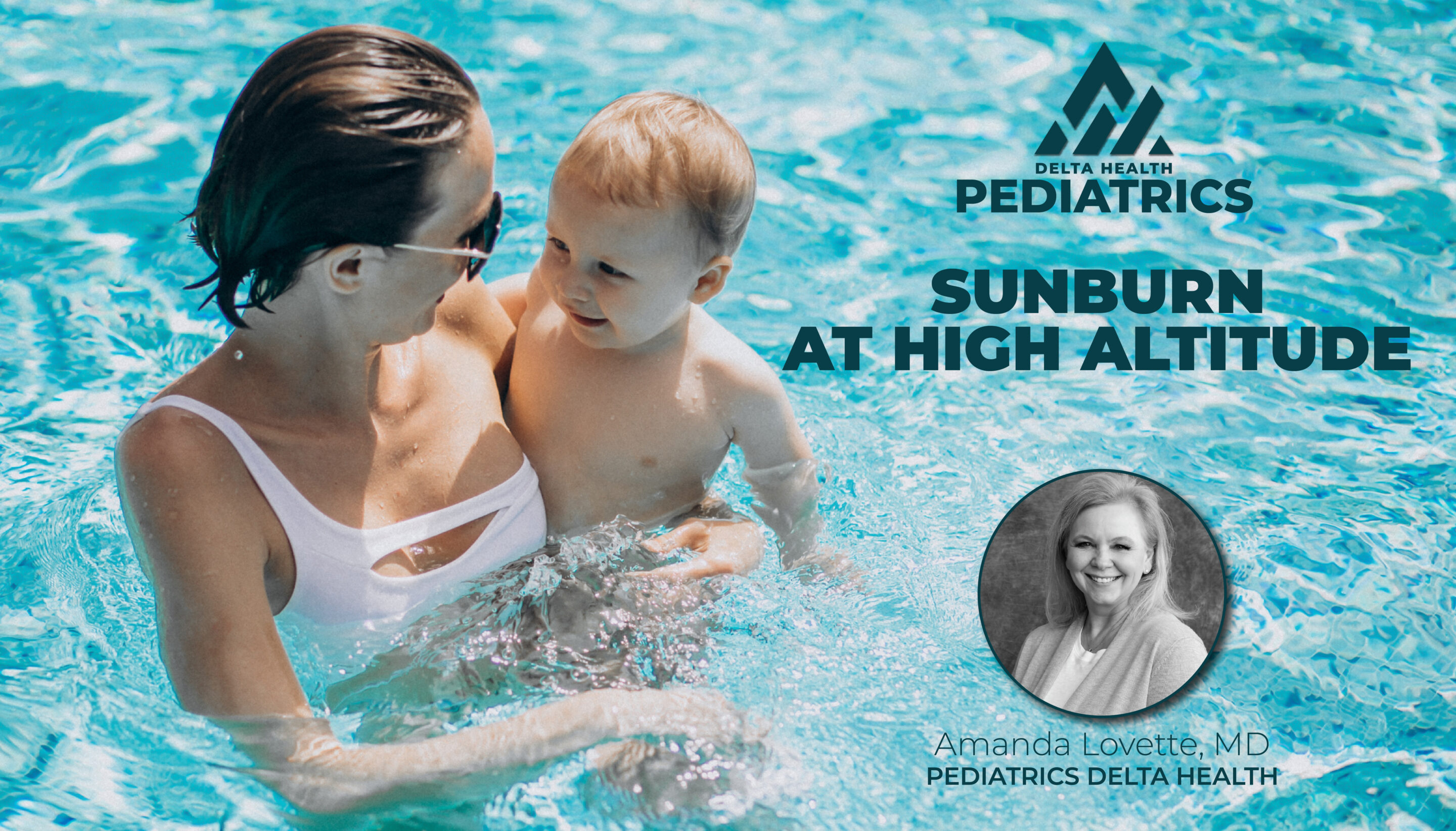Amanda Lovette, MD, Delta Health Pediatrics
The breathtaking vistas, the crisp mountain air, the sense of adventure—nothing quite compares to the exhilaration of scaling great heights. We who live in Colorado will soon be seeking out these high mountain views because that is just what you do when you live in Colorado. There will be many visiting from lower altitudes as well, and they will also be marveling at our beautiful mountains. However, amidst the allure of altitude lies a hidden danger: sunburn. While the sun’s rays can feel invigorating, warm, and cozy at elevation, they can also be deceptively harsh and unforgiving, leading to severe consequences for those of us who underestimate their strength.
What are the risks of the sun at altitude? At higher elevations, the atmosphere is thinner, offering less protection against ultraviolet (UV) radiation from the sun. As a result, individuals are more susceptible to sunburn and all its accompanying risks.
Sunburn at altitude can be particularly severe due to several factors:
- There is increased UV radiation exposure with altitude, because the atmosphere is thinner and doesn’t filter out UV radiation as well. With every 1000 meters (3280 feet) gained in elevation, UV levels can increase by about 10-12%. This heightened exposure can lead to quicker and more severe burns.
- At altitude, the cooling effect of wind can mask the sensation of burning, leading people to underestimate their sun exposure until it’s too late.
- Snow, ice, and water at high altitudes can reflect UV rays, intensifying exposure and increasing the risk of sunburn.
Unfortunately, there can be serious repercussions of sunburn at altitude that extend far beyond the initial discomfort. Chronic sun exposure, even in a single incident of severe sunburn, can have long-lasting effects, including:
- Premature Aging: Sunburn accelerates skin aging, leading to wrinkles, fine lines, and sagging skin. That may not matter to your 5 year old right now, but when she is 50 and looks much older, it can matter very much to her.
- Skin Cancer: Prolonged UV exposure increases the risk of developing skin cancer, including melanoma, the deadliest form of the disease.
- Eye Damage: UV radiation can also cause damage to the eyes, leading to conditions such as cataracts and macular degeneration. These diseases can arise many years after the initial exposure.
So, you still want to travel to altitude to enjoy the views – what steps can you take to keep your children safe from severe sunburns? Here are some essential tips:
- Of course, it goes without saying, that you need to use sunscreen. Apply a broad-spectrum sunscreen with SPF 30 or higher to all exposed skin, including lips and ears. Reapply every two hours, or more frequently if sweating or swimming. People often forget the reapplication step – please don’t, for the sake of your and your child’s skin. Put a reminder on your phone if necessary.
- Wear protective clothing, such as long sleeves, pants, wide-brimmed hats, and sunglasses with UV protection.
- Take regular breaks in the shade, especially during peak UV hours (10 a.m. to 4 p.m.).
- People underestimate how quickly they can become dehydrated at altitude, and dehydration can exacerbate the effects of sunburn. Drink plenty of water throughout the day, even if you don’t feel thirsty.
If your child falls victim to sunburn at altitude, prompt treatment is crucial to alleviate discomfort and prevent further damage:
- Apply cool, damp compresses to the affected area to soothe the skin and reduce inflammation.
- Encourage your child to drink plenty of water to prevent dehydration.
- Apply aloe vera gel or lotion to the sunburned skin to promote healing and provide relief.
- Over-the-counter pain relievers such as ibuprofen or acetaminophen can help alleviate discomfort.
- Keep your child out of the sun until the sunburn has healed completely to prevent further damage.
While the allure of altitude calls us to explore, it’s essential to recognize the hidden dangers that accompany elevation, particularly the risk of sunburn. By taking proactive measures to protect against UV exposure and knowing how to treat sunburn if it occurs, we can ensure that our mountain adventures are not only exhilarating but also safe and enjoyable for all. Entire vacations have been ruined because of children who are miserable with sunburns. These tips will help protect your family and your trip!
For more information, contact Delta Health Pediatrics at 970.546.4000 or visit deltahealthco.org/delta-health-pediatrics/. Delta Health Pediatrics has walk-in appointments available Tuesdays, Wednesdays and Fridays from 8:00 a.m. to 5:00 p.m. as well as same-day appointments available Monday through Friday. Please call the clinic to schedule an appointment.
More tips, articles and videos from Dr. Lovette can also be found online by joining the Healthy Kids Western Slope Facebook Group at facebook.com/groups/healthykidswesternslope/.


